How to grow sweet peas from seed – in borders and pots
Find out how to grow sweet peas and where to enjoy their wonderful color, ruffled blooms and sweet fragrance in your garden
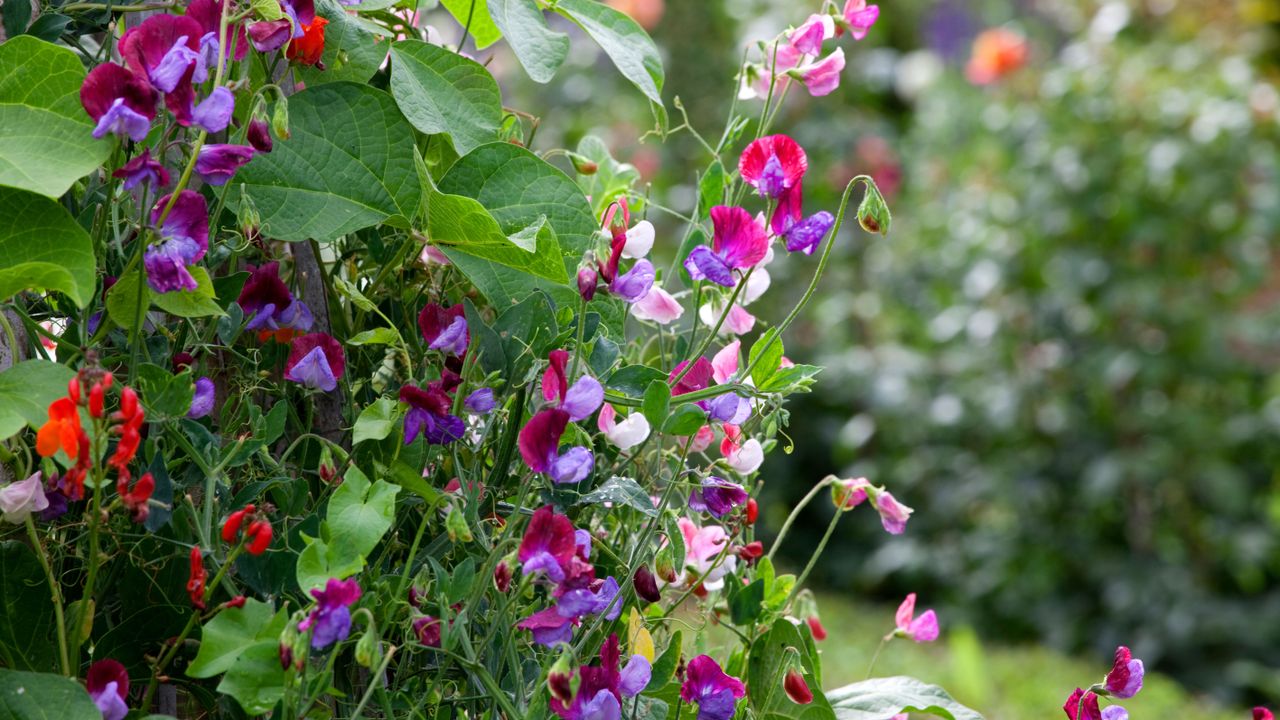

It is worth learning how to grow sweet peas so that you can enjoy these delicately beautiful, highly-scented flowers both in your garden and around the home as cut flowers.
These old-fashioned favorites are stalwarts of cottage garden ideas, where their frilly blooms in myriad colors can be enjoyed scrambling up obelisks, trained up trellis and supports, and filling borders with their heady scent.
If you are planning a cut flower garden, they are a brilliant choice and are available in nearly every shade to complement many floral displays.
There is nothing like burying your face into a freshly picked bunch. 'In a nutshell, sweet peas are the scent of summer. They have been called “the Queen of Annuals” and it would be hard to think of another annual that could compare for popularity,' says specialist grower Philip Johnson of Johnson’s Sweet Peas.
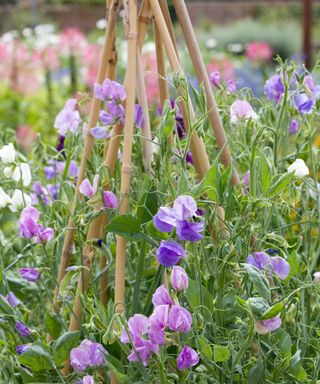
How to grow sweet peas
Relatively easy to grow, sweet peas are among the best fragrant flowers and have been grown in our gardens for centuries as part of flower bed ideas.
These typical cottage garden plants need to be sown in cool weather and tend to do better in places with cooler weather, preferring mild winters and cooler summers. They tend to begin blooming just before the temperature starts to really rise. Summer-flowering varieties are recommended for growing outside in areas where summers are not too hot and winters milder.
‘I like growing sweet peas up wigwams or tripods, because you can then put them in the border and they rise up and you get the colour working in with the plants around them,’ says the celebrity gardener Monty Don in Gardener’s World.
Alternatively, if you don’t have a large garden and are wondering how to grow sweet peas, they can easily be grown in deep containers as a patio planting idea or on a balcony garden provided they have vertical support.
'What used to be a few varieties of highly-scented, relatively small flowers, the sweet pea has been developed over the years for the home gardener to enjoy a plant that really does do it all. Whether that’s longer stems and larger flowers perfect for cut flowers, or perhaps a strong scent and a longer flowering season, the sweet peas now can do it all,' says Molli Christman, horticulturist at RHS Hyde Hall.
There are now options of dwarf bush types, which grow 9-25 inches (25-60cm) tall, and are sturdy, without the need for much support, making them useful for containers and in borders. However, the majority are climbing varieties that are trained up trellis, sticks, and fences, growing 6 to 9 feet (2 to 3 meters) tall.
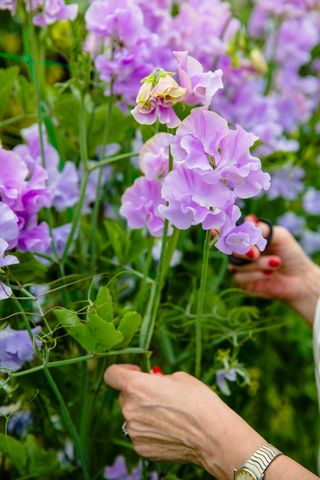
Although they have garnered a reputation for being a bit of a diva, it is well worth the effort to learn how to grow sweet peas, and, given the right conditions, they will more than reward you with the results.
'Today, there is such a range of colors, types and sizes available that extend their adaptability. They range from the Cupid type that reaches only a few inches in height to the vigorous Spencers that can easily attain a height of eight feet or more, with several types in between. Colors vary from white to the deepest maroon and there are varieties with markings to suit many tastes – ripples, flakes and bicolors, to name but a few. With a little care and attention they can provide flowers from late spring to early fall or even longer if you're planning a greenhouse,' adds Philip Johnson.
Growing sweet peas from seed
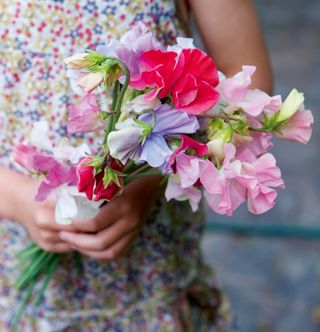
Sweet peas are best grown from seed. You can either sow the seeds directly in the ground in cool weather, in fall or spring, or in containers indoors to be then hardened off and planted out in mid-spring.
Preparing your sweet pea seeds will help you get the best results from growing sweet peas. Place the seeds on damp blotting paper or kitchen paper towel for 24 hours and also nick the outer coat of the seed with a sharp blade or nail clippers so it can absorb water better.
Follow this step-by-step guide on how to grow sweet peas from seed in containers:
1. To encourage strong and vigorous root growth, sow sweet peas into root trainers or 3 inch pots filled with a mixture of potting compost and 20 per cent sand. Plant a single seed about 1cm deep into each cavity, cover with compost and water. To assist germination, place them in a greenhouse or on a sunny windowsill.
2. Sweet peas are hardy, so once the seedlings have sprouted the sweet peas can be moved outside into a cold frame or a sheltered area of the garden to get maximum sunlight.
3. Once the seedlings have developed two pairs of leaves, pinch out the growing shoot just above the top pair to encourage more vigorous side shoots.
4. Before the seedlings are ready to be planted out in spring, it’s important to prepare your site. Sweet peas are hungry plants, so fertilize the soil by digging in plenty of well rotted manure or organic matter. At this stage you can also prepare your supporting structure. Sweet peas are climbing plants and are best grown up a vertical support such as an obelisk, wigwam or jute netting.
6. In late March to April, the plants are ready to be planted out. Plant a seedling at the base of each bamboo cane or obelisk support by digging a hole deep enough to accommodate the long roots, infilling with soil and watering in well. Planting in a cluster of three will create a more rambling look.
7. After a couple of weeks, once the plants have established and developed secondary shoots, select the strongest shoot and remove the others, this will encourage a stronger plant and larger blooms.
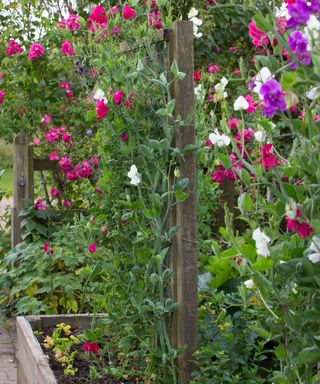
Alternatively, you can sow your sweet peas direct in the ground in fall or spring, first preparing the ground by adding in well-rotted homemade compost or manure.
When sowing directly use a tool or stick to make a furrow as it is important to bury the seeds at one-inch depth, placing each seed 3-5 inches (10-15cm) apart, and then after sowing cover the seeds without creating a mound, before gently watering the soil.
'You can also sow extras indoors as a precaution, planting them out once they are well-established seedlings,' adds Molli Christman.
If you have started your seeds inside you will need to harden off the seedlings before transplanting into your garden once all risk of frost has passed.
Where is the best place to plant sweet peas?
As sweet peas are among the best flowering climbers, have supports in place before planting so you don’t disturb them. Avoid planting by a wall, as air needs to circulate freely.
Sweet peas need ample sunlight and do poorly when shaded. Select an open spot in rich, well-drained but moisture-retentive soil, amended with compost or composted manure. Except on naturally alkaline soils, lime should be added to the soil at about one cup per square meter on light soils, and two on heavier. Mulching will keep the roots cool and retain moisture while growing.
For optimum flowering, sweet peas like their heads in the sun and the roots deep in cool and moist earth. They also need lots of room, both width and depth. Planting too closely together can create an environment for powdery mildew and reduced flowers. And of course, choose a spot that’s easy to access for regular picking.
Sweet peas are particularly at home in vegetable gardens or cutting gardens, scrambling up wigwams or string cordons among a medley of edibles and ornamentals. The added bonus is that sweet peas are good plants for pollinators, especially bees, being rich in nectar and pollen, and so are good for companion planting. The flowering pillars are ideal for wildlife garden ideas.
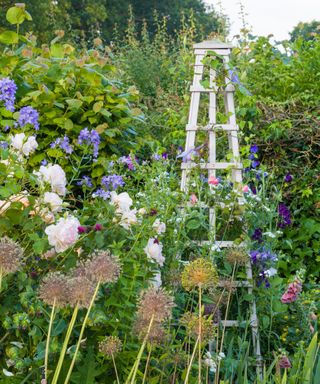
Caring for sweet peas
Once you have mastered how to grow sweet peas you need to know how to care for them.
Sweet peas will start blooming approximately 4-6 weeks after visible vining. Regular maintenance will keep the plant flowering. To keep it fuller, pinching it back will encourage side shoots, as will snipping off the central vines just above leaf joints and deadheading.
As mentioned, they make fabulous cutting garden flowers. And as the days get longer, they will grow and flower faster. Always pick your sweet peas for the vase in the morning before the sun has time to dehydrate them. Select freshly opened flowers on the longest stems and remember not to cut the main stem of the plant, only the side-flowering stems. They may only last up to 5 days in a vase but what a glorious few days!
Deadheading by trimming back the old flowers left for display encourages new growth right into late summer or the beginning of fall. To deadhead, follow the stalk down of the spent flower to a set of leaves and trim just above the node. Sweet pea flowers are fairly long-lasting but when they eventually dry out with the summer heat they turn to seed.
If you want to try collecting seeds, however, for next year, leave some of the best flowers on the plant as the best will provide the best seeds. Seeds are ready for harvesting when they are brown and dry and the pods are just starting to pop open. The saved seeds should be viable for 3-5 years. Keep in mind though that the seeds may not produce plants that are the same color as the parent plant.
As well as watering use a liquid feed regularly for good growth and flowers. Water every day unless it has rained.
'Sweet peas never like to be dry, especially when in full growth, and enjoy plenty of food to produce all those blooms. A good base dressing, when planting, of Fish, Blood, and Bone and later on weekly feeds of a soluble plant fertilizer will keep them happy. But remember to feed the plant as well as the flowers, so alternate with a tomato fertilizer,' advises Philip Johnson.
Fortunately, the only pests that attack the flowers are aphids, which tend to appear after a dry spell when plants are under stress. Wash them off with regular blasts of water.
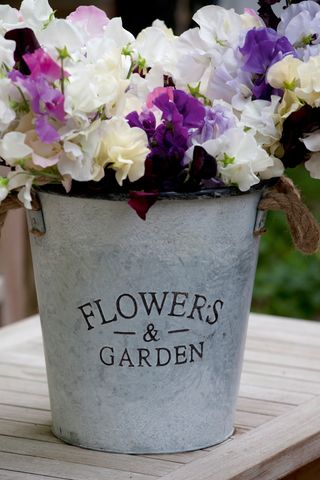
What is the best way to grow sweet peas?
The best way to grow sweet peas is from seed. Sweet peas are hardy annuals and only need protection from harsh frosts; sowing them in fall will give them an early start and a chance to establish really strong root growth before being planted out in spring.
Another key thing to remember when growing sweet peas, is that they are hungry and thirsty plants, so it is important to fertilize the soil and to keep them well watered, around once a week. ‘Make sure you add lots of organic matter, if nothing else to act as a reservoir to hold moisture for them,’ advises Monty Don.

Do sweet peas need to climb?
Yes, all sweet peas are climbing plants and are best grown up a vertical supporting structure such as an obelisk, wigwam, jute netting, or other vertical garden ideas.
If you want to learn how to grow sweet peas as a cut flower then they can also be cordon-grown, up individual canes set in a row as part of a purpose-built structure.
In the first month of growth, your plant will need help to guide it with twine or clips, checking it every couple of days. Once the tendrils form and grab hold you will need to check it’s growing as desired. Some gardeners snip off the tendrils and keep manually tying in the plant. Pinching out the tips of the plant by nipping off the top of the stem with your fingers above a set of leaves encourages side shoots.
'I use two techniques for growing sweet peas. The first, requiring lots of time and care, is the cordon. You start with a single sweet pea shoot tied to an upright support. As the plant develops you will need to remove all side shoots and tendrils, tying the plant up to the support as it grows, which forces the plant to concentrate its energy on producing a strong central stem with larger, but fewer, flowers. The second technique I use is much more natural, by using pea sticks and not pinching any side shoots or tendrils out, letting the plants develop to provide its own support and creating a mass of smaller flowers,' explains Molli Christman.
'We grow sweat peas up teepees made from hazel or bamboo gathered from the garden. If you have a balcony or terrace you can also grow them in a large pot up a narrow teepee. We plant two seedlings at the base of each hazel stick. We tie them in as they climb, with twine, and make sure to cut them every day once they are flowering to stop them from going to seed,' explain Henrietta Courtauld and Bridget Elworthy of the Land Gardeners.
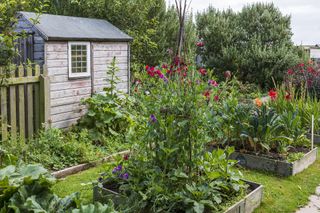
How much sun do sweet peas need?
Sweet peas need a good amount of sunlight, but grow best in cooler conditions in moist, free-draining soil and do not like getting too hot. ‘Don’t put them in a blazing sunny position and above all make sure they don’t get dry,’ reveals the celebrity gardener Monty Don on Gardener’s World. ‘They will need watering once a week unless it is very wet.’
Can sweet peas be grown in pots?
Yes, sweet peas can be grown in pots as part of your container gardening ideas.
For containers, use a peat-free compost with a loam compost and mix in a slow-release fertiliser. 'Generally speaking, sweet peas perform better in the ground rather than in pots. It is so easy to forget to water them and then it can be difficult to get them back into top gear again. However, there are several less vigorous types that respond well to growing in containers,' says Philip Johnson of Johnson's Sweet Peas.
He lists among those suitable for growing in containers, Cupid and Solway types, but warns to avoid 'the popular Spencer types, which tend to be rather vigorous and rarely perform at their best when grown in containers,' he says.
Containers and raised beds need to be at least 17 inches (45cm) deep to not inhibit growth. Raised garden beds can be a great way to grow sweet peas if your soil is boggy as drainage is improved.
How often should you water sweet peas?
You should water sweet peas regularly in dry weather. A dry soil makes sweet peas go to seed quicker and flower stems shorter so sweet peas should never be allowed to dry out.
It is important to know when to water plants. If you put your finger to its first joint into the soil and it feels dry, water them. Damping down the surrounding area and spraying the foliage with cool water is also beneficial in hot spells to keep the plant in good condition.
Sign up to the Homes & Gardens newsletter
Design expertise in your inbox – from inspiring decorating ideas and beautiful celebrity homes to practical gardening advice and shopping round-ups.

Pippa is a contributor to Homes & Gardens. A graduate of Art History and formerly Style Editor at Period Living, she is passionate about architecture, creating decorating content, interior styling and writing about craft and historic homes. She enjoys searching out beautiful images and the latest trends to share with the Homes & Gardens audience. A keen gardener, when she’s not writing you’ll find her growing flowers on her village allotment for styling projects.
- Leigh ClappContributing Editor
-
 This refined and eclectic Sydney home is a lesson in how to go big on creativity in a small space
This refined and eclectic Sydney home is a lesson in how to go big on creativity in a small spaceA heady mix of European styles, including Art Deco and Baroque, are referenced by Tamsin Johnson in this revived home
By Ruth Corbett Published
-
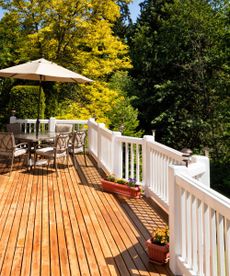 Best wood for a deck – experts reveal the 7 best tree species that combine longevity with style, to elevate your outdoor living space
Best wood for a deck – experts reveal the 7 best tree species that combine longevity with style, to elevate your outdoor living spaceThere a lots of different wood species for decking, but which is best? I spoke to decking experts to find out the best wood for a deck
By Alex David Published
-
 Water garden ideas – 9 ways to introduce soothing water to your outdoor space
Water garden ideas – 9 ways to introduce soothing water to your outdoor spaceFrom cascading fountains to wildlife ponds, there are plenty of ways to create a tranquil water garden
By Leigh Clapp Published
-
 How to grow poppies
How to grow poppiesFind out how to grow poppies to enjoy the beauty of these brightly colored tissue paper-like blooms
By Leigh Clapp Published
-
 How to grow delphiniums from seed
How to grow delphiniums from seedFind out how to grow delphiniums from seed and enjoy these colorful cottage garden favorites filling beds and borders
By Leigh Clapp Published
-
 How to grow ferns – when and how to plant and care for them
How to grow ferns – when and how to plant and care for themLearn how to grow ferns to enjoy the texture and form of these versatile plants in many areas of your garden
By Leigh Clapp Published
-
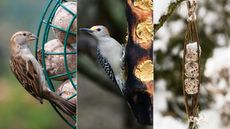 How to make fat balls for birds – easy steps feed our feathered friends
How to make fat balls for birds – easy steps feed our feathered friendsLearn how to make fat balls for birds to ensure their wellbeing throughout the winter
By Holly Reaney Published
-
 Planning a kitchen garden – from layouts to picking the best crops
Planning a kitchen garden – from layouts to picking the best cropsPlanning a kitchen garden is easy with this expert advice – whether yours is in beds, borders or a dedicated patch – you're guaranteed success
By Leigh Clapp Published
-
 How to grow cosmos – expert tips on when and where to plant these flowers
How to grow cosmos – expert tips on when and where to plant these flowersLearn how to grow cosmos to add bright color in your garden from summer through to fall with their beautiful blooms
By Leigh Clapp Published
-
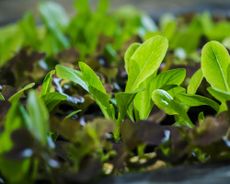 How to grow spinach – indoors or outdoors for healthy leaves
How to grow spinach – indoors or outdoors for healthy leavesFind out how to grow spinach in containers or in the garden to have a year round supply of these delicious and healthy leaves
By Rachel Crow Last updated